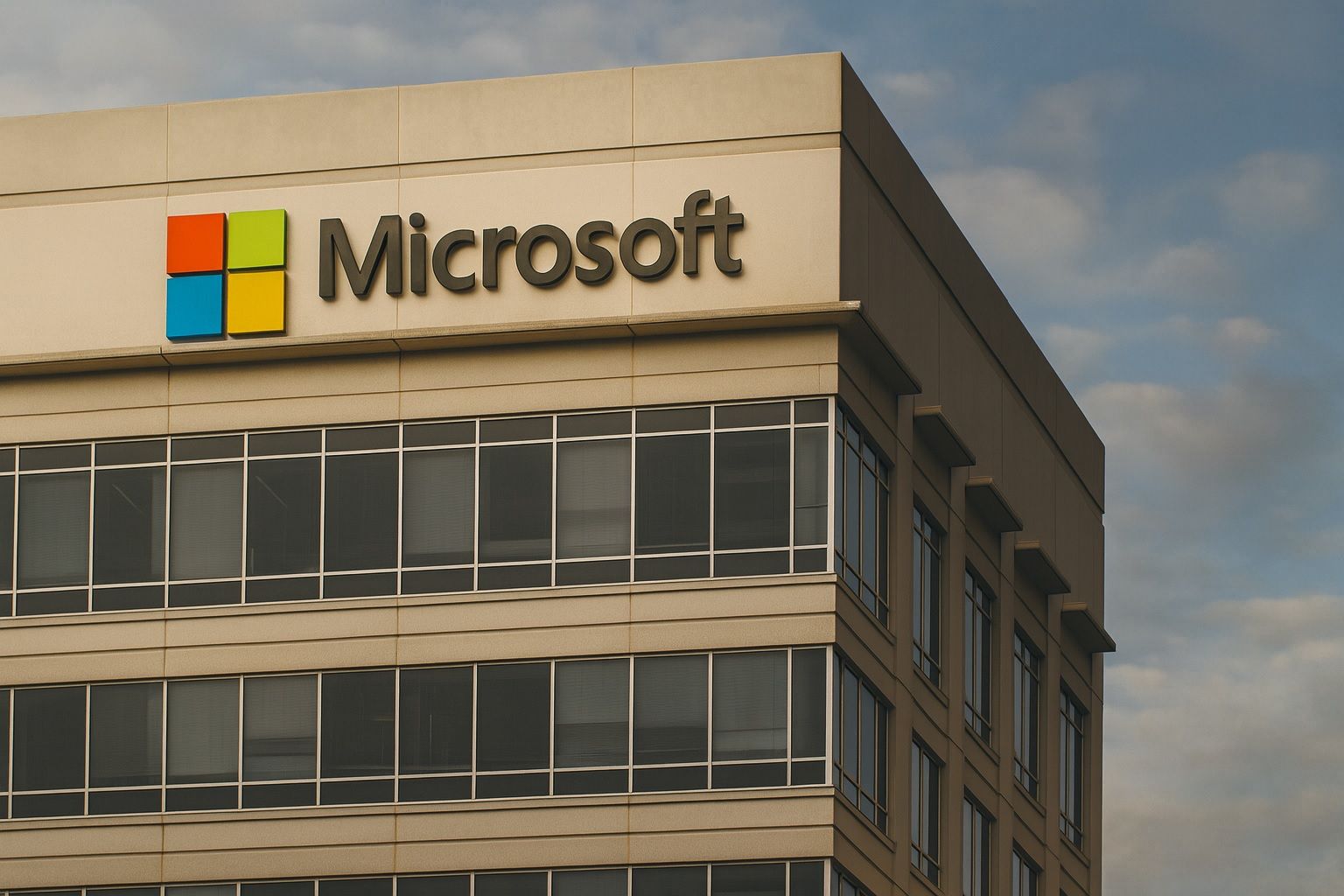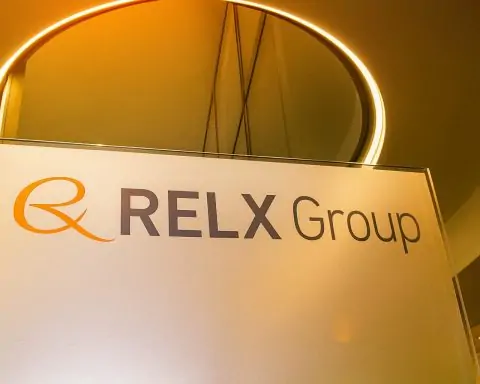- Price & Performance (Oct 10, 2025): ~$510.96 (NASDAQ: MSFT close price [1]). The stock has a 52-week range of roughly $345–$555 [2] [3], and is up about +23% year-over-year [4]. Over the past 5 trading days it slipped ~–1.2% [5], but month-to-date it’s slightly positive (+1.6%) [6].
- Market Cap: ≈$3.80 trillion [7], making it one of the world’s most valuable companies.
- Valuation: P/E ~38× and P/S ~13× (TTM) [8]. Dividend yield ~0.7% [9] [10]; recently raised 10% to $0.91/share per quarter [11].
- FY2025 (FY ends June): Revenue $281.7B (+15%), operating income $128.5B (+17%) [12] [13]. Q4 FY2025 (ended June) sales $76.44B (+18% YoY) with EPS $3.65 (beat est. $3.35) [14]. Azure revenue for the year topped ~$75B (up 34%) [15], while total Microsoft Cloud (Azure + 365 + Dynamics) surpassed $168B (+23%) [16].
- Business Highlights: Commercial Office/M365 revenue grew +16% in Q4; Consumer Office/M365 +21% [17]. LinkedIn revenue +9% in Q4 [18] (LinkedIn now has ~1.2 billion members and 4th year of double-digit user growth [19]). Dynamics 365 (CRM/ERP) sales +23% [20]. Xbox content/services revenue +13% in Q4 [21]. (Xbox Game Pass now has ~50 M subs.)
- Cloud & AI: Azure growth remains the standout (Azure +39% in Q4) [22]. Microsoft is rolling out its AI Copilot assistant across products (MS 365 Copilot now in pilot to millions) and just reported Copilot MAUs exceeded 100M [23]. Ongoing AI investments include record capital spending (guidance ~$30B next quarter) [24], plus major deals (e.g. ~$19B Nebius GPU deal, 100K+ Nvidia Blackwell GPUs [25]).
- Analyst Sentiment: Strongly positive. 33 of 34 analysts rate MSFT a “Buy” [26] (none Sell). Consensus price target ~$618 (implying ≈+21% upside) [27]. Targets range from ~$550 up to ~$710 [28]. 24/7 Wall St. notes the median target ~$626 (≈+20% upside) [29]. Stonehage Fleming calls Microsoft “a leader in enterprise AI” [30], and Morgan Stanley recently made MSFT a Top Pick with a $625 target [31].
Stock Price & Recent Performance
Microsoft’s stock price reached a record high of about $555.45 on July 31, 2025 [32]. Since then it has pulled back modestly, closing around $510.96 on Oct 10, 2025 [33]. Over the last week MSFT dipped ≈–1.2%, though it remains +23.1% higher than a year ago [34]. (In extended trading on Oct 13, the stock was up sharply, reflecting early optimism, trading near $518.4 [35].) MarketBeat notes the average 12-month target is about $618 [36] (21% above current levels), while some analysts’ top targets approach $650–$700 [37].
Trading metrics remain high: market cap ~$3.8 trillion [38], P/E near 38 (TTM) [39], and dividend yield ≈0.7% [40] [41]. In terms of technical trend, MSFT has been in a clear uptrend. On the daily chart the stock has formed higher lows and trades above its short-term moving averages [42]. Key support is seen around $506–$513 (recent volume peak levels [43]), while resistance is near $520 (the recent swing high) [44]. The Relative Strength Index (RSI ~56) and MACD are positive, indicating room before becoming overbought [45]. (See chart below.)
Chart: MSFT daily price (Oct 2025). The stock recently broke above ~$520 resistance (dashed line) on earnings-driven momentum, staying above the rising 10-day MA [46]. Technical indicators (MACD, RSI) remain bullish, suggesting an uptrend continuation.
Recent News & Events (Past Week)
Microsoft has been in the headlines for several strategic developments in early October 2025:
- LSEG Partnership (Oct 13, 2025): Microsoft and the London Stock Exchange Group announced a deepening of their multi-year alliance. The pact will enable LSEG’s vast financial dataset to be accessed within Microsoft’s Copilot and 365 platforms [47]. Copilot agents can leverage this “AI-ready” financial data (33+ petabytes of licensed content) to provide real-time analysis for banks and traders [48]. This strengthens Microsoft’s push in financial services AI.
- Azure AI Supercluster (Oct 10): Azure revealed the deployment of the first large-scale AI cluster using Nvidia’s new GB300 NVL72 chips. The initial cluster contains over 4,600 of Nvidia’s latest Blackwell GPUs, co-engineered with Microsoft, marking “the first of many” as Azure scales to hundreds of thousands of such GPUs [49]. This massive infrastructure is designed to power frontier AI models (e.g. for OpenAI) and underscores Microsoft’s record capital spending on AI.
- Elevate Washington (Oct 9): Microsoft launched “Elevate Washington,” a new initiative to bring AI education to every student and teacher in its home state [50]. Led by Brad Smith, the program includes AI curriculum, training, and tools in every school, reflecting Microsoft’s broader commitment to expanding AI usage responsibly in society.
- Other Updates: Microsoft will release its Q1 FY2026 results after market close on Oct 29, 2025 (earnings call 2:30pm PT) [51]. This earning date has been announced following the quarter just ended. On Oct 7, Microsoft announced a partnership with payments platform Checkout.com, bringing Azure’s cloud + AI to enterprise payments (aimed at faster, more secure digital transactions) [52]. And in consumer tech, Xbox continues to build momentum – new titles like Ninja Gaiden 4 are arriving on Game Pass (Oct 21) [53], and the company remains focused on expanding its gaming ecosystem (over 50M Game Pass subs, 1.9B hours of gameplay streamed in FY25, etc.).
Analyst Commentary & Forecasts
Wall Street’s view on MSFT remains overwhelmingly bullish. The consensus among 34 analysts is a Moderate Buy (32 Buys, 2 Holds) [54]. MarketBeat reports an average 12-month price target of about $618.47 [55] (roughly 21% above current levels). The range of targets is wide – roughly $475 at the low end up to $710 at the high end [56] – reflecting both conservative and aggressive views on AI-driven growth.
For example, 24/7 Wall St. notes that 33 of 34 analysts covering MSFT have Buy ratings [57]. The median price target among them is ~$626, implying roughly +20% upside [58]. (Their cautious year-end target of $563 still implies a 7–8% rise from here.) Many analysts cite Microsoft’s AI and cloud leadership as the catalyst. Morgan Stanley recently named MSFT a “Top Pick”, raising its target to $625 and praising the company’s cloud/AI growth trajectory [59].
Industry experts and media figures have echoed the optimism. For instance, Stonehage Fleming strategist Gerrit Smit says MSFT is “becoming more of a cloud infrastructure business and a leader in enterprise AI” [60]. Wedbush’s Dan Ives (often cited on CNBC) has floated targets up to ~$650–710 in longer-range forecasts, foreseeing Microsoft approaching a $5 trillion valuation on AI alone (though not all analysts are that aggressive). Even Jim Cramer (CNBC) has mentioned MSFT among top AI picks. In sum, the Street “buys” Microsoft’s story, projecting continued double-digit growth in cloud/AI businesses and solid capital returns.
Financials & Valuation
Microsoft’s latest reported quarter (FY25 Q4, ended June 30) was strong. Revenue was $76.44 billion (+18% YoY) with EPS $3.65, topping expectations [61]. Azure and cloud services remain high-growth engines: Q4 Azure (and “other cloud”) revenue was up 39% [62], and Microsoft Cloud (Azure + 365 + Dynamics) grew ~27% to $46.7 billion for the year [63]. As CEO Nadella highlighted, “Microsoft Cloud surpassed $168 billion in annual revenue” (up 23% YoY) [64]. CFO Amy Hood also noted a record $368 billion of contracted backlog, reflecting future cloud service commitments [65].
Productivity products showed steady growth. In Q4, Microsoft 365 Commercial (enterprise Office 365 cloud) revenue grew +16% (18% in constant currency) [66], and M365 Consumer grew +21% [67], lifted by continued Office 365 and Teams adoption. LinkedIn revenue rose +9% [68], as members and usage expand (platform activity is up 20–30%). On the games side, Xbox content and services grew +13% in the quarter [69] (helped by new titles and Activision content). Activision integration remains a key driver – 24/7 Wall St. notes gaming revenue would have been +44% higher if not for the one-time Activision accounting treatment, suggesting solid underlying growth.
Key valuation metrics: MSFT’s P/E (TTM) ~37.7 [70], P/S ~13.6 [71], and dividend yield ~0.7% [72]. TS2.tech notes these multiples are similar to peers (Apple ~35×, Alphabet ~26×) [73]. The Board recently raised the quarterly dividend 10% to $0.91 [74] (payable Dec 2025), underscoring confidence. Microsoft also returned $9.4 billion to shareholders in Q4 (dividends + buybacks) [75].
Investors are watching upcoming guidance: analysts expect revenue and margins to reflect elevated AI-related spending. Microsoft has warned that FY2026 capex will be at “record” levels (~$30B next quarter [76]) to fuel data-center buildout, which could pressure near-term free cash flow. However, management emphasizes that AI investments will pay off in more efficient software (e.g. 90% higher token throughput per GPU) [77] and higher-margin cloud revenue over time.
Business Unit Outlook
Azure & Cloud: This is Microsoft’s fastest-growing segment. Azure (plus Azure-adjacent services) still grows on the order of +30–40% annually [78]. The recent quarters show accelerating demand from enterprise AI workloads: Azure accelerated to +39% YoY growth in Q4 [79]. By comparison, AWS growth is ~17%, Google Cloud ~32% [80], so Azure remains the pace-setter among hyperscalers. Major AI customers (OpenAI, enterprises running Copilot, etc.) are signing multi-year contracts on Azure. Citigroup has even lifted its forecast for cloud AI spending to ~$2.8 trillion by 2029, which would disproportionately benefit Azure [81]. Microsoft is also pursuing cloud AI partnerships: it recently added Anthropic’s models to its Copilot engine and will build dedicated AI GPU capacity via partners (e.g. the Nebius deal) rather than solely internal data-centers [82] [83]. In sum, the cloud unit should keep growing strongly, though margins may fluctuate with heavy capex in the near term.
AI Initiatives & Copilot: Microsoft is rapidly embedding AI across its portfolio. Over 70% of Fortune 500 are deploying Microsoft AI solutions, and Microsoft 365 Copilot is being rolled out in Office apps, Windows, and Dynamics. Copilot now has >100 million monthly active users across commercial and consumer products [84] [85]. New features (e.g. agentic Copilot “Agent Mode”, AI-generated avatars, industry-specific knowledge agents) are continuously launched [86]. On Windows PCs, the impending end-of-support for Windows 10 (Oct 14, 2025) is expected to spur upgrades and new PCs with Copilot built-in (Windows 11 25H2 just started rolling out [87]). These AI initiatives should boost subscription and device sales.
Productivity & Business Apps: Office 365, Teams, and related cloud apps remain reliable earners. As noted, M365 Commercial revenue was up +16% in Q4 [88], driven by Office subscriptions and Enterprise Mobility/Security. The Microsoft 365 suite (Office + Teams) is also bundling Copilot AI (already previewed to many customers), which could enhance value and pricing power. Dynamics 365 (CRM/ERP) is another bright spot – Q4 Dynamics revenue grew +23% [89] as businesses invest in cloud-based operations. Microsoft has also been streamlining its go-to-market (e.g. unbundling Teams from Office 365 pricing in Europe) to comply with regulators while still monetizing services. Overall, the Productivity & Business Processes segment is expected to grow in the mid-to-high teens, supported by enterprise digitization, cloud migrations, and AI features.
LinkedIn: The social network continues steady growth. Q4 LinkedIn revenue was +9% (8% CC) [90]. The hiring (Talent Solutions) business has been slightly soft post-pandemic, but Microsoft expects mid-single-digit LinkedIn growth in the next quarter (due to Talent Solutions improvement) [91]. Engagement metrics on LinkedIn are strong (comments up 30%, video uploads +20% [92]), and Microsoft is infusing AI tools into LinkedIn (e.g. AI agents for recruiting and sales). With 1.2B members [93], LinkedIn’s long runway in professional networking and advertising should continue contributing a low-single-digit share of MSFT sales.
Gaming & Xbox: Gaming (More Personal Computing) was the slowest-growing segment in Q4, with content/services +13% [94]. This is still solid given the Activision World of Warcraft accounting and console cycle timing. Starfield, Halo, and Call of Duty titles continue to drive franchise sales. Xbox Game Pass subscriptions grew (roughly 50M now), and Microsoft is expanding Game Pass to new markets and bundles (e.g. including EA Play). The launch of new hardware (Xbox Series X|S) is in a late-cycle mode, so near-term gaming growth will rely on software and services. The recently announced 50% price increase for Game Pass will boost average revenue per user, but may weigh on near-term sub growth. Long-term, the integration of Xbox cloud gaming and potential AI-driven gaming experiences (e.g. AI NPCs) are areas to watch.
Enterprise Services & Security: Microsoft’s enterprise server and cloud services (hosted on Azure) showed healthy growth: server products and cloud services revenue was up 26% in Q4 [95]. Dynamics and Azure are part of this. Additionally, Microsoft’s security business is accelerating. The company launched a Security Store (AI-driven app marketplace) and redefined Microsoft Sentinel as an “agentic” AI security platform [96]. These moves deepen the attach rates of high-margin security products to Microsoft 365 and Azure. Microsoft’s partnerships also extend into other verticals: for example, Checkout.com announced it will use Azure’s infrastructure to power its payments platform [97]. Overall, enterprise and cloud services should keep growing in the double digits, fueled by ongoing digital transformation and AI adoption, while highly scalable nature helps margins over time.
Technical Analysis
MSFT Daily Chart (Oct 2025) – As of mid-October, Microsoft’s daily chart is bullish. Price is above its 10-day moving average, forming higher lows (support ~$506–$513) and has recently broken above the $520 resistance level [98]. The RSI (~56) indicates room before overbought territory, and the MACD (in the lower pane) is trending up, confirming positive momentum [99]. Volume patterns show upticks on up-days, suggesting institutional accumulation. Key levels to watch: a breakdown below $506 would be a bearish trigger, while a sustained break above $530 could signal another leg up. (The chart above shows the annotated support/resistance and indicator signals.) In summary, technical indicators align with the fundamental bullish case – MSFT is in an uptrend and pulling back only slightly after earnings.
Expert Insights & Conclusion
Microsoft’s long-term outlook remains centered on AI and cloud leadership. Many experts emphasize the company’s enormous competitive “moat” – a massive installed base, enterprise trust, and deep AI ecosystem. For example, Reuters quotes emphasize MSFT’s “widening moat” and successful transformation into a cloud/AI powerhouse. Stonehage Fleming’s Gerrit Smit succinctly calls Microsoft “a leader in enterprise AI” [100]. Morgan Stanley has made MSFT its Top Pick, citing strong “AI/cloud growth and broadening drivers” (target ~$625) [101]. Market participants note that unlike many tech peers, Microsoft retains strong profitability (gross margins ~70%) even as it invests heavily in data centers.
In sum, as of October 2025, Microsoft’s stock is trading near its all-time highs on the back of robust earnings, aggressive AI infrastructure buildout, and ongoing cloud momentum. Key near-term catalysts include the upcoming Oct 29 earnings (expectations: revenue ~$73–74B, EPS $3.25–3.45) and any guidance around capex and margins. Longer-term, the company’s growth will likely be driven by Azure/AI adoption, Copilot rollouts, and cross-selling of high-value services across its ecosystem. With a fortress balance sheet and secular AI tailwinds, Microsoft is well-positioned. Analysts’ consensus remains bullish, with most projecting double-digit upside over the next year. Investors should watch for confirmation of growth (especially in Azure and Copilot subscription metrics) and manage expectations around near-term spending. Overall, MSFT appears poised to remain a core holding, with several analysts forecasting targets in the $600–700 range (some even higher) over the coming 12–18 months [102] [103].
Sources: Official Microsoft earnings releases and investor calls [104] [105], market data (TradingView/MSFT [106] [107]), industry analyses (TS2.tech [108] [109], 24/7wallst [110], MarketBeat [111]), and news from Microsoft (Source Blog [112] [113] [114]), Azure blog [115], Xbox Wire [116], LinkedIn News [117], and reputable media (Reuters, CNBC, Bloomberg insights as cited). All figures and quotes are current as of mid-Oct 2025.
References
1. stockanalysis.com, 2. ts2.tech, 3. www.tradingview.com, 4. www.tradingview.com, 5. www.tradingview.com, 6. www.tradingview.com, 7. www.tradingview.com, 8. www.tradingview.com, 9. ts2.tech, 10. www.tradingview.com, 11. ts2.tech, 12. ts2.tech, 13. ts2.tech, 14. 247wallst.com, 15. www.microsoft.com, 16. ts2.tech, 17. www.microsoft.com, 18. www.microsoft.com, 19. news.linkedin.com, 20. www.microsoft.com, 21. www.microsoft.com, 22. www.microsoft.com, 23. ts2.tech, 24. ts2.tech, 25. www.techradar.com, 26. 247wallst.com, 27. www.marketbeat.com, 28. www.marketbeat.com, 29. 247wallst.com, 30. ts2.tech, 31. ts2.tech, 32. www.tradingview.com, 33. stockanalysis.com, 34. www.tradingview.com, 35. stockanalysis.com, 36. www.marketbeat.com, 37. www.marketbeat.com, 38. www.tradingview.com, 39. www.tradingview.com, 40. ts2.tech, 41. www.tradingview.com, 42. copygram.app, 43. copygram.app, 44. copygram.app, 45. copygram.app, 46. copygram.app, 47. news.microsoft.com, 48. news.microsoft.com, 49. azure.microsoft.com, 50. blogs.microsoft.com, 51. news.microsoft.com, 52. ukstories.microsoft.com, 53. news.xbox.com, 54. www.marketbeat.com, 55. www.marketbeat.com, 56. www.marketbeat.com, 57. 247wallst.com, 58. 247wallst.com, 59. ts2.tech, 60. ts2.tech, 61. 247wallst.com, 62. www.microsoft.com, 63. www.microsoft.com, 64. ts2.tech, 65. ts2.tech, 66. www.microsoft.com, 67. www.microsoft.com, 68. www.microsoft.com, 69. www.microsoft.com, 70. ts2.tech, 71. ts2.tech, 72. ts2.tech, 73. ts2.tech, 74. ts2.tech, 75. ts2.tech, 76. ts2.tech, 77. ts2.tech, 78. www.microsoft.com, 79. www.microsoft.com, 80. ts2.tech, 81. ts2.tech, 82. ts2.tech, 83. www.techradar.com, 84. ts2.tech, 85. ts2.tech, 86. ts2.tech, 87. ts2.tech, 88. www.microsoft.com, 89. www.microsoft.com, 90. www.microsoft.com, 91. www.staffingindustry.com, 92. news.linkedin.com, 93. news.linkedin.com, 94. www.microsoft.com, 95. ts2.tech, 96. ts2.tech, 97. ukstories.microsoft.com, 98. copygram.app, 99. copygram.app, 100. ts2.tech, 101. ts2.tech, 102. www.marketbeat.com, 103. ts2.tech, 104. 247wallst.com, 105. www.microsoft.com, 106. www.tradingview.com, 107. www.tradingview.com, 108. ts2.tech, 109. ts2.tech, 110. 247wallst.com, 111. www.marketbeat.com, 112. news.microsoft.com, 113. news.microsoft.com, 114. ukstories.microsoft.com, 115. azure.microsoft.com, 116. news.xbox.com, 117. news.linkedin.com








